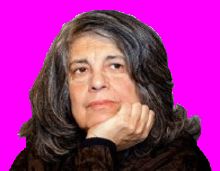 about the choices she made in terms of her public (sexual) identity.
about the choices she made in terms of her public (sexual) identity.(I know, I know, many blogs and critics have already flogged this point extensively, but as I say in my headline, it's a "bandwagon" I just had to get on since Sontag was and is one of my intellectual and political heroes.) Plus, I have long admired Bronski's critiques, so why not feature him in J's Theater when the opportunity arises?
I've amended this entry to add a link suggested by Reggie H.: Arthur C. Danto's loving tribute in Artforum. He calls Sontag an "aesthetician hero" (though shouldn't this be "aesthetician-hero?"). One interesting point I'd note is that two key figures in Sontag's thought that he doesn't mention, two "lovers," would have to be Friederich Nietzsche (especially the Nietzsche of The Death of Tragedy), and Walter Pater (of the famous "Conclusion" to Studies in the Renaissance). Nietzsche attempts to overthrow the tyranny of rationality, of cold Apollonian order, the "system" that goes all the way back to Plato and which Hegel codifies, for something more synthetic, dangerous, alive, that captures those dark and illimitable spaces in human experience and existence, and Sontag's criticism and fiction are many things but not systematic; while Pater urges us to live utterly in the moment, to capture each precious sensation, to make, as Wilde would formulate in another way, the life as the work of art, which Sontag definitely did. (Gertrude Stein, Marcel Duchamp, Meret Oppenheim, Arnold Schoenberg, Igor Stravinsky, Guy Debord, Andy Warhol, Yves Klein, Joseph Beuys, Vito Acconci, Jean-Michel Basquiat, Adrian Piper, William Pope.L, etc., are other figures who've shown ways this might or might not work.) Sontag took both Nietzsche and Pater increasingly to heart, as I suggested to Reggie H., especially in her notion of "an erotics of art," especially as she grew older. An aesthetician-hero, and heroic figure, indeed.
***
A few books I've been looking at (not counting course texts) of late:
- The Rest of Love by Carl Phillips
- Neue Geschichten. Hefte 1-18 by Alexander Kluge (literally looking, as my German isn't sharp enough to read these narratives other than glacially, especially during a teaching quarter; New Directions has just published a selection of stories from his collection Die Lücke, die der Teufel läßt [The Devil's Blind Spot], which I also will write about soon.)
- Give My Regards to Eighth Street: Collected Writings of Morton Feldman, ed. B. H. Friedman
- The Last Will and Testament of Señor Da Silva by Germano de Almeida
- Silence by John Cage (I return to this and several of Cage's other texts about once every few years)
- Polysexuality (Semiotext[e] #10), ed. Jim Fleming and Sylvère Lotringer (this one was sitting on my bookshelf, and several commentaries by Charles S. on his now-wiped blog (!) led me to retrieve it after having not opened it for almost a decade)
- The World Republic of Letters by Pascale Casanova (All it took was a stellar review in The Nation to get me to rush out and buy this book, which I cannot put down, and actually assigned at the last minute to one of my classes)
- Fourteen Female Voices from Brazil, selected and edited by Elzbieta Szoka, with an introduction by Jean Franco









No comments:
Post a Comment